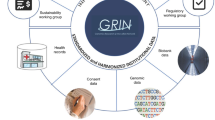Abstract
There are many challenges in conducting rare disease research. The conditions are often poorly understood, small patient populations are dispersed around the world, and there are limited funding opportunities. Patient groups can serve as a key partner in overcoming these challenges, as they understand the impact of rare conditions on patients’ lives. This gives patient groups valuable scientific insights into the disease. This can be used to create research strategies, address research bottlenecks and directly fund research that appropriately addresses patient needs. Patient groups can also play a critical role in recruiting and retaining patients for clinical trials, which reduces time and resource waste. By partnering with patient groups, research teams can improve efficiency of research and best meet the needs of patients. Researchers can also play an important role in building and supporting patient groups to unlock these benefits.
This is a preview of subscription content, access via your institution
Access options
Subscribe to this journal
Receive 12 print issues and online access
$259.00 per year
only $21.58 per issue
Buy this article
- Purchase on Springer Link
- Instant access to full article PDF
Prices may be subject to local taxes which are calculated during checkout
Similar content being viewed by others
References
Rare Disease UK, 2016. The rare reality—an insight into the patient and family experience of rare disease. Available at: https://www.raredisease.org.uk/media/1588/the-rare-reality-an-insight-into-the-patient-and-family-experience-of-rare-disease.pdf (accessed on 16 January 2017).
Global Genes, 2017. RARE disease: facts and statistics. Available at: https://globalgenes.org/rare-diseases-facts-statistics/ (accessed on 16 January 2017).
Raffai F . Patients as partners. Rare Revolution Magazine 2016; 2: 48–50.
Mavris M, Le Cam Y . Involvement of patient organisations in research and development of orphan drugs for rare diseases in Europe. Mol Syndromol 2012; 3: 237–243.
BHD Foundation. Interview transcript—Lindsay Middelton, R.N., C.G.C. Available at: https://www.bhdsyndrome.org/wp-content/uploads/2011/10/Lindsay-Middelton-transcript.pdf (accessed on 9 February 2017).
Stevenson D. Pleural covering as an alternative treatment for recurrent pneumothorax. BHD Foundation, 2015. Available at: https://www.bhdsyndrome.org/forum/bhd-research-blog/pleural-covering-as-an-alternative-treatment-for-recurrent-pneumothorax/ (accessed on 9 February 2017).
Department of Health, 013. The UK strategy for rare diseases. Available at: https://www.gov.uk/government/uploads/system/uploads/attachment_data/file/260562/UK_Strategy_for_Rare_Diseases.pdf (accessed on 9 February 2017).
Association of Medical Research Charities, 2014. An essential partnership: a guide for charities working with industry. Available at: http://www.amrc.org.uk/sites/default/files/doc_lib/Essential_Partnership.pdf (accessed on 19 April 2017).
Association of the British Pharmaceutical Industry, 2015. Working together, delivering for patients. A guide to collaboration between charities and pharmaceutical companies in the UK. Available at: http://www.abpi.org.uk/our-work/library/Documents/ABPI_NV_Guide_FINAL.pdf (accessed on 19 April 2017).
Kayadjanian N, Burghes A, Finkel R, Mercuri E, Rouault F, Schwersenz I et al. SMA_EUROPE workshop report: opportunities and challenges in developing clinical trials for spinal muscular atrophy in Europe. Orphanet J Rare Dis 2013; 8: 1–3.
Cano S . Rasch analysis of clinical outcome measures in spinal muscular atrophy. Muscle Nerve 2014; 49: 422–430.
European Neuromuscular Centre, 2016. Workshop report: revisiting the consensus statement for standards of care in SMA. Available at: http://www.enmc.org/publications/workshop-reports/revisiting-consensus-statement-standards-care-sma (accessed on 7 February 2017).
European Medicines Agency, 2016. Spinal muscular atrophy workshop. Available at: http://www.ema.europa.eu/ema/index.jsp?curl=pages/news_and_events/events/2016/07/event_detail_001310.jsp&mid=WC0b01ac058004d5c3 (accessed on 19 April 2017).
AMRC—Association of Medical Research Charities, Amrc.org.uk, 2017. Sector data. Available at: http://www.amrc.org.uk/our-members/sector-data (accessed on 31 January 2017).
Findacure, 2016. The rare disease drug repurposing social impact bond (RDDR SIB). Available at: http://www.findacure.org.uk/drug-repurposing/ (accessed on 25 January 2017).
European Medicines Agency, 2006. Guideline on clinical trials in small populations. Available at: http://www.ema.europa.eu/docs/en_GB/document_library/Scientific_guideline/2009/09/WC500003615.pdf (accessed on 25 January 2017).
Cox T, Ranganath L . A quantitative assessment of alkaptonuria: testing the reliability of two disease severity scoring systems. J Inherit Metab Dis 2011; 34: 1153–1162.
Bachenheimer J, Brescia B. Reinventing Patient Recruitment: Revolutionary Ideas for Clinical Trial Success, 1st edn. Gower Publishing Ltd: Aldershot, UK, 2007..
Data Monitor, 2008. Online recruitment is streamlining clinical trials.
Timmis O. AKU case study. Patients4Data, 2014. Available at: http://www.patients4data.co.uk/files/AKU_Case_Study.pdf (accessed on 25 January 2017).
CISCRP, 2013. Report on clinical trial information seekers, 2013. Perceptions and insights study. Available at: https://www.ciscrp.org/download/2013-perceptions-insights-study-clinical-trial-information-seekers/?wpdmdl=6646 (accessed on 25 January 2017).
PTEN UK & Ireland Patient Group, 2017. About us. Available at: http://ptenuk.weebly.com/about.html (accessed on 6 February 2017).
Akusociety.org, 2017. AKU Trustees. Available at: http://www.akusociety.org/aku-trustees.html (accessed on 31 January 2017).
Findacure, 2017. Our scientific advisory committee. Available at: http://www.findacure.org.uk/about-us/ (accessed on 31 January 2017).
Author information
Authors and Affiliations
Corresponding author
Ethics declarations
Competing interests
FR is the Executive Director of Findacure and a trustee of the Cambridge Rare Disease Network. OT is the CEO of the AKU Society. The authors have no other relevant affiliations or financial involvement with any organisation or entity with a financial interest in or financial conflict with the subject matter or materials discussed in the manuscript. This includes employment, consultancies, honoraria, stock ownership or options, expert testimony, grants or patents received or pending, or royalties.
Rights and permissions
About this article
Cite this article
Raffai, F., Timmis, O. Building the patient community. Gene Ther 24, 547–550 (2017). https://doi.org/10.1038/gt.2017.33
Received:
Revised:
Accepted:
Published:
Issue Date:
DOI: https://doi.org/10.1038/gt.2017.33
This article is cited by
-
Meet the researchers: an alternative method of engaging patients with research in mesothelioma
Research Involvement and Engagement (2018)


